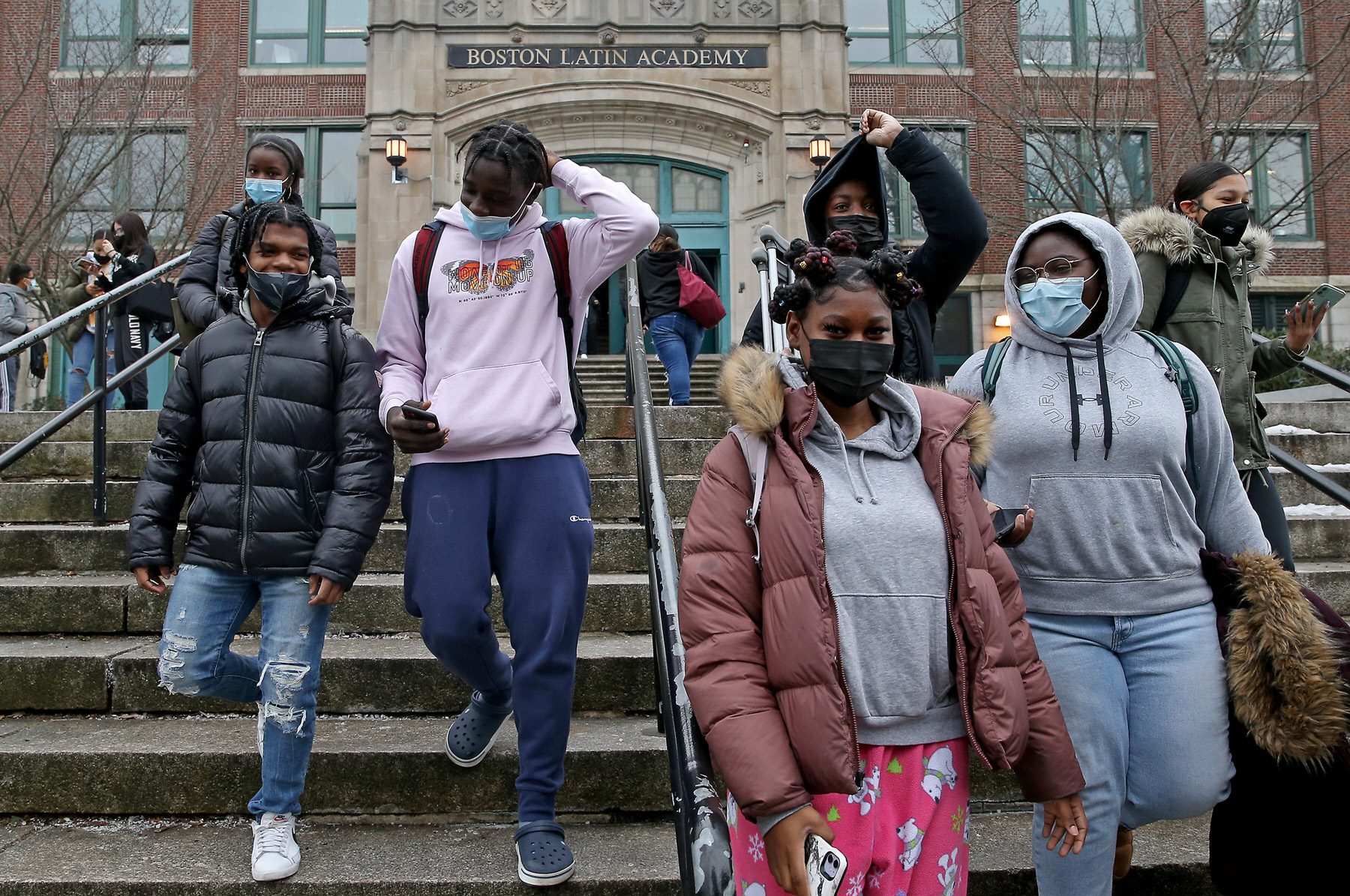Tiffany Luo, a senior at Boston Latin School, regularly cares for her older grandmother, her little brother and her two small cousins. She worries she’s going to be the one who exposes them to COVID-19: Students at her school wear low-quality masks and are crowded inside for lunch, she said.
She wants distance learning to count toward the 180 days that Massachusetts public schools are required to be in session. But Gov. Charlie Baker has refused to change the state’s rule that counts only in-person days. So Luo, 17, and other Boston students are protesting, walking out of class to draw attention to their demands for remote learning, better protective equipment and improved testing.
“We want to continue our education, but we shouldn’t be risking our lives or our families’ lives to have a quality education,” said Luo, a representative of the Boston Student Advisory Council (BSAC), a group of elected student leaders advocating for youth in public high schools citywide.
The demonstrations led by BSAC last week, which included a walkout, students staying home and a webinar with speeches from their peers, families and nurses, were one of a number of student-led actions across the country in recent weeks in response to COVID safety measures. Last week, students walked out of schools in New York City, Chicago and Columbia, Missouri, to demand more protections as cases surge. On Tuesday, Oakland students began a strike for improved safety measures as their teachers took part in a sickout.
Like Luo, many of the activists spearheading these demonstrations are young women or girls. At Brooklyn Technical High School in New York — where hundreds of students poured out of class January 11 because of their concerns about COVID, kickstarting similar protests nationally — the organizers of the walkout were both girls. That’s not a coincidence but part of a larger movement of girl-led activism that’s gained visibility over the past 15 years due to the work of youth such as Malala, who advocated for girls’ education in Pakistan, and climate activist Greta Thunberg, according to Jessica Taft, a professor at the University of California – Santa Cruz who researches youth activism. In Flint, Michigan, Mari Copeny, now 14, has directed attention to that city’s water crisis for years.
“What we’ve seen in high school is that when there are student movements, they tend to be led by girls and young women,” said Taft, who has researched high school girl activists for more than 20 years. “And that’s not just in the U.S. That’s fairly true across the globe. Some of that [is because], at times, they do have more at stake. They’re more vulnerable on various issues. Also, a lot of it has to do with girls’ gender socialization to care for community and to care for others — the idea that you’re supposed to love the world, look out for other people and have a sense of interdependence with other people.”
It doesn’t surprise Taft that a student like Luo, a family caregiver, is organizing at Boston Latin, since “girls are more likely to be in these kinds of caring positions in their families and to be attuned to the needs of the sort of wider community that they’re caring for.”
Luo said that some of her classmates have waved away her concerns about COVID because they believe it’s not a serious illness for the vaccinated population. But she’s heard about people who’ve developed long COVID, or long-lasting symptoms after contracting the virus. She does not want to take a chance with the health of her loved ones.
“It was like a huge anxiety, every time I went to school, knowing that I could come home and bring it back to these highly vulnerable individuals,” she said. Also, if she gets sick, she won’t be able to care for her grandmother and young relatives, she said.
Although girl activism has become newly visible in the 21st century, Taft said, it is not new. In the 1970s, high school girls walked out of school to protest dress codes and sexual harassment, she said. But the pandemic particularly lends itself to girl-led activism because fighting the virus centers on the desire to protect individuals more vulnerable than oneself, according to Taft. Too often, high school boys are socialized to behave as if nothing, even a global pandemic, scares them, so admitting how fragile life can be doesn’t “necessarily align with certain versions of young masculine toughness,” she argued.
Boys, especially athletes, make up the bulk of students who oppose Luo’s efforts, the teen told The 19th. Even boys from other school districts have contacted her on social media to object to her efforts to bring back remote learning because they don’t want their athletic seasons cut short, she said.
They’ve told her that they don’t believe COVID is real, she added, or that they’ve already had the virus and recovered without developing serious health problems. Some have tried to intimidate her: “They’re saying that I should mind my own business, and I should just stay home and never attend school,” Luo said.
According to Taft, girl activists typically face “very specific kinds of dismissals and intimidation and harassment.” It can take the form of critiquing their looks or characterizing them as too noisy or disruptive to be adequately “feminine.” Often, as in Luo’s case, girls are simply dismissed as “not knowing what they’re talking about,” Taft said. “There are all kinds of dismissals that they face as well as some real threats of harm, really intense forms of harassment and bullying.”
The girls fighting for safety precautions during the Omicron surge have not only faced backlash from peers but also accusations that they just want to skip school. It’s a charge that Rommy Sasson, an 11th-grade organizer of the walkout at Brooklyn Tech, finds preposterous: They just don’t want to get sick or continue to attend half-empty classes because so many of their teachers and classmates are already out sick. She said students walked out of class last week to avoid missing school due to COVID-19 in the near future.
As it is, “the people who are attending school are attending a somewhat diminished version of in-person education,” she said, referring to staffing shortages at schools. She pointed out that students walked out before finals week, a key time for preparation. “Large numbers of students decided that this walkout and fighting for this cause to keep students and staff safe was in many ways more important for this one day than maintaining the grades they’ve worked so hard to achieve. It really takes a dire situation to get Brooklyn Tech students to skip their classes and walk out.”
Although they’ve faced criticism, the organizers have also won support from some of the adults in their communities. In Boston, both politicians and parents have supported the young activists. U.S. Rep. Ayanna Pressley and state lawmakers including Massachusetts Rep. Tram T. Nguyen have voiced their support for their concerned students, and Mayor Michelle Wu has described Baker’s ban on remote schooling as “too rigid.”
Sarah Horsley of the group BPS (Boston Public Schools) Parents for COVID Safety has participated in protests with the students as well as adults — mostly mothers and grandmothers, she said, concerned about their families during the latest COVID surge. Most recently, Horsley joined Friday’s webinar organized by Boston youth.
“Students are saying they are afraid for their health and their family’s lives,” said Horsley, parent of a BPS third-grader. “In some cases, students are sharing that they have grandparents who are fragile health-wise. They’re sharing that they’re afraid for their teachers who are out with COVID. So in terms of walking out, this is a way to kind of say, ‘Hey, wake up. This is how strongly we feel about this. Listen to us.’”
So far, student protests have yielded some conversations but no major shifts in policies. In New York City, Department of Education Chancellor David C. Banks invited student organizers to meet with him about their concerns with school safety during the coronavirus crisis. Classes in Boston and New York City remain in person. But Sasson hopes this recent burst of youth activism will ultimately make a difference and spur her peers to action.
“I hope that the fact that we’re girls leading this movement can give inspiration to other girls and women out there who might only be exposed to a lot of male role models,” she said.







